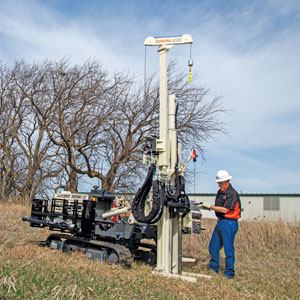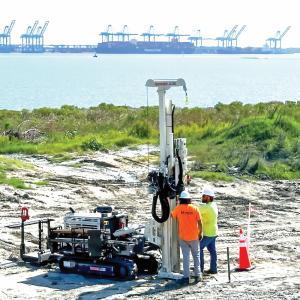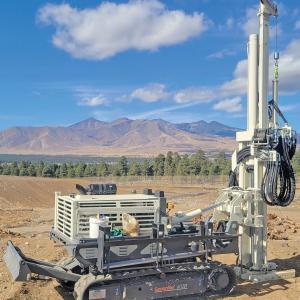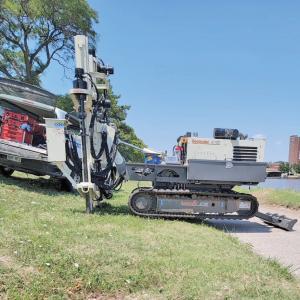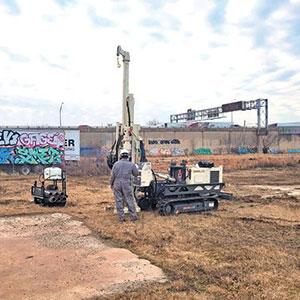
Conceptual Site Model after High Resolution Site Characterization. The figure shows the combination of HPT (brown) and OIP (purple) data emphasizing the identification of a confining layer. This confining layer (showed in red signs) controls the fate and storage of contaminants in the site.
One of the most important factors for the success of remediation activities is the knowledge of the subsuperficial characteristics.
Finkler Ambiental, a company based in Vinhedo in the state of São Paulo, Brazil, is using high resolution tools and soil permeability testing equipment such as Membrane Interface Hydraulic Profiling Tool (MiHPT) and Optical Image Profiler (OIP) to provide more complete data for the characterization of complex sites. A feedback and research relationship with the Geoprobe® research and development team is maintained to improve the application of these tools in an environment with the much different geotechnical characteristics found in Brazil.
In one project, a well-known site underwent a high-resolution pilot project. The site is a storage plant for different fuels and has more than 300 monitoring wells. Despite many years of characterization, remediation, and pressure from the local environmental regulatory agency, there were uncertainties in its conceptual site model about the source and state of the recurrent free phase product.
One area of interest was selected for a pilot project to demonstrate the capabilities of the OIP and HPT systems. Nine OIP logs and one HPT log were completed to identify subsurface characteristics to determine target areas of future remediation efforts.
Once the logs were completed, a confining low-permeability layer was characterized by the soil permeability testing equipment. This zone is placed among two layers with higher permeability values. Even though this low-permeability layer was visually similar to its surroundings, its permeability was lower than the other two. The previous works conducted in the site described the layers as homogeneous and did not detect its lower permeability properties.
Historically, the monitoring wells were placed above or below this layer, thus creating high pumping rates of water but low oil recovery rate. Therefore, the remediation efforts were never conclusive until this point.
“Once there is a clear understanding and interpretation of the results it is possible to optimize the remediation efforts. The client did not know the technologies, OIP and HPT, but after the concluding results of the pilot project the whole area will undergo a high-resolution approach for future work. There won’t be any other installation of wells or sampling campaigns before more high-resolution work is done,” said Cesar Malta, Finkler high-resolution investigations manager.
Despite the limited number of OIP and HPT logs, there was a great acceptance by the client and local environmental agency once the information was gathered and the results presented. These tools bring more agility and precision to current and future remediation efforts.
Contact Us
1835 Wall Street
Salina, Kansas 67401
Phone: (785) 825-1842
Related Articles
6712DT delivers the power and agility needed for injection point projects.
ID: 14614 | Date:
6712DT's size and power is perfect for not only soil sampling and landfill gas collection but also monitoring well installation.
ID: 14363 | Date:
Pairing the 6712DT with the 20CPT Press makes a system that is faster, safer, and more efficient.
ID: 14362 | Date:
Direct Image® Tooling provides high-quality data in the unforgiving geology of Alaska.
ID: 14360 | Date:
Primarily roaming within a 100-mile radius of Philadelphia, TRISTATE ENVIRONMENTAL MANAGEMENT SERVICES performs a broad range of environmental field services in New Jersey and Southeast Pennsylvania. Project Manager Ted Sobieski credits their “jack-of-all
ID: 13417 | Date:
Related Videos
ID: 14050
Geoprobe® MD4 Display Overview
ID: 13461
ID: 1909
Geoprobe® 20CPT Press Overview
ID: 1897
ID: 6608
ID: 5344
ID: 1997
ID: 1996


